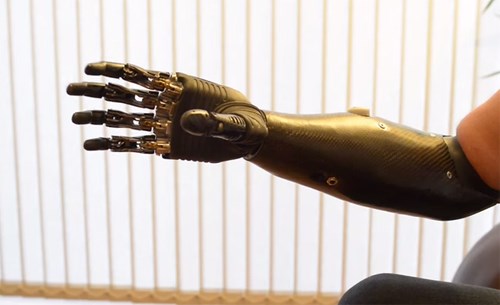2014 SBIR funding solicitations are short on composites
However, the industry should note trends revealed in the areas DoD prioritizes for technology research and transfer.

Prosthetic limbs fabricated from composites are among the SBIR-funded projects
that are garnering more attention.
Out of the 21 topics released online in the U.S. Department of Defense (DoD) fiscal year (FY) 2014.3 Small Business Innovation Research (SBIR) funding solicitation, only one directly lists composites. The description for “Replacement Nose Fairing Material” is listed below. Instead, most of the research topics deal with sensors, microelectronics or modeling and computing, though the Navy’s subgroup includes “Optimization of Advanced Wireless Textiles” and “Advanced Textile Manufacturing Using 3D Printing”.
For the composites industry, the take-home is to note the push to integrate sensors into everything, from cargo containers to clothing to the next generation of night vision goggles. In the case of containers — the Defense Threat Reduction Agency’s (DTRA) topic “Smart Materials to Indicate Personnel Presence in Proximity to Container” — the DoD would like to replace cameras, infrared sensors and visual inspection by guard forces with a means to maintain security that does not require staffing and is not easily disabled. The research description suggests that integrated/embedded sensors will need to detect multiple signatures, for example motion, body heat and molecular compounds emitted during breathing.
Another interesting topic is the Defense Advanced Research Projects Agency’s (DARPA) “Energy Harvesting for Next Generation Neurotechnology”. Basically the DoD wants to advance Neuroprosthetics — which already can actuate prostheses based on closed-loop sensing and computation — by replacing batteries with biomedical energy harvesting technologies. This also reflects a larger trend outside the military. Bionics are here. They are still expensive and in development, but they are no longer science fiction. Both of the devices in the videos below from Ekso Bionics and BeBionic use carbon fiber composite laminates.
Prosthetics has always been a market for composites, but with advances in electronics and injured troops returning from Iraq and Afghanistan, the push to improve this technology into self-powered neuroprosthetics that are actually affordable has ramped significantly.
Finally, there is another round of funding available for awards in 2014, this one known as the DoD FY 2014.B Small Business Technology Transfer (STTR) Solicitation. Of the 13 topics included here, only DARPA’s “Revolutionary Airlift Innovation” implies composites, seeking unmanned gliders to perform cargo lift operations from ship to unsecured shore areas. The Missile Defense Agency (MDA) topic "Failure Avoidance in Microelectronics Due to Coefficient of Thermal Expansion (CTE) Mismatch of Substrates and Adhesives” reflects a large trend in the printed circuit board (PCB) industry — reportedly the largest consumer of glass fiber — to develop higher laminate performance and thermal capacity as electronics get smaller and more sophisticated. Watch for our full-length feature on that in the October issue of Composites Technology magazine.
NAVY N143-130 Replacement Nose Fairing Material
DESCRIPTION: The Nose Fairing provides hydrodynamic and aerodynamic stability during launch and flight. The Nose Fairing provides a direct interface during onload and offload of the missile while supporting the entire weight of the missile. Navy Strategic Systems Programs (SSP) desires to develop a replacement material with the following parameters:
Service Life Goal - 50 years
Nominal Thickness - 0.5 inch
Tensile Strength – Longitudinal > 8.0 ksi Property quantified to B-Basis**
Tensile Strength – Hoop > 2.5 ksi Property quantified to B-Basis**
Bending Strength – Longitudinal > 5.0 ksi
Shear Strength > 1.6 ksi Property quantified to B-Basis**
Internal material damping - Loss Factor = 0.01 or higher
Radio Frequency Transparent in the GigaHertz region of the electromagnetic spectrum (EM) spectrum
Density - 0.58 gm/cc.
Manufacturability – Must be able to form into a complex curvature (doubly curved shell of revolution)
**At least 90 percent of the population of values is expected to equal or exceed the B-basis mechanical property allowable, with a confidence of 95 percent.
REFERENCES:
1) Payload Fairing. http://en.wikipedia.org/wiki/Payload_fairing
2) Nose Fairings on Rockets and Ballistic Missiles. http://www.gpo.gov/fdsys/pkg/GPO-CRPT-105hrpt851/pdf/GPO-CRPT-105hrpt851-2-6.pdf
KEYWORDS: Strategic Missiles; Composite Materials; Materials Development; RF transparent structural materials; Ultrastrong materials; Nanocomposites
TPOC: Roderick Santander
Phone: (202)433-5839
Email: roderick.santander@ssp.navy.mil
2nd TPOC: David Olson
Phone: (202)433-5807
Email: David.Olson@ssp.navy.mil
Related Content
Plant tour: Albany Engineered Composites, Rochester, N.H., U.S.
Efficient, high-quality, well-controlled composites manufacturing at volume is the mantra for this 3D weaving specialist.
Read MoreThe potential for thermoplastic composite nacelles
Collins Aerospace draws on global team, decades of experience to demonstrate large, curved AFP and welded structures for the next generation of aircraft.
Read MoreCombining multifunctional thermoplastic composites, additive manufacturing for next-gen airframe structures
The DOMMINIO project combines AFP with 3D printed gyroid cores, embedded SHM sensors and smart materials for induction-driven disassembly of parts at end of life.
Read MoreInfinite Composites: Type V tanks for space, hydrogen, automotive and more
After a decade of proving its linerless, weight-saving composite tanks with NASA and more than 30 aerospace companies, this CryoSphere pioneer is scaling for growth in commercial space and sustainable transportation on Earth.
Read MoreRead Next
Plant tour: Daher Shap’in TechCenter and composites production plant, Saint-Aignan-de-Grandlieu, France
Co-located R&D and production advance OOA thermosets, thermoplastics, welding, recycling and digital technologies for faster processing and certification of lighter, more sustainable composites.
Read MoreAll-recycled, needle-punched nonwoven CFRP slashes carbon footprint of Formula 2 seat
Dallara and Tenowo collaborate to produce a race-ready Formula 2 seat using recycled carbon fiber, reducing CO2 emissions by 97.5% compared to virgin materials.
Read More“Structured air” TPS safeguards composite structures
Powered by an 85% air/15% pure polyimide aerogel, Blueshift’s novel material system protects structures during transient thermal events from -200°C to beyond 2400°C for rockets, battery boxes and more.
Read More


















